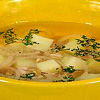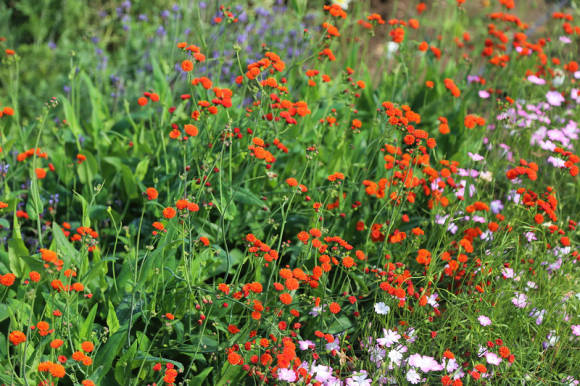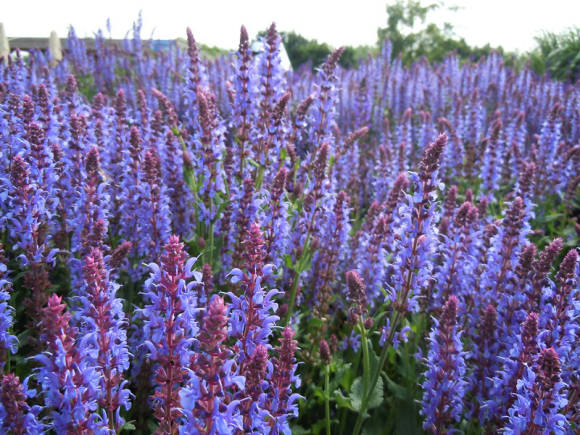 Europeans grow dozens of species and varieties of wolfberry, one more beautiful than the other. True, they call this bush a beautiful name - Daphne. Some species, such as undersized ones: Daphne alpina, Daphne arbuscula, Daphne jezoensis, it is worth trying to grow with us, in case they fall into your hands. Judging by the available information, they can endure snow-free frosts down to -15 "C, and possibly even lower. And since their height does not exceed 20-60 cm, their chances of surviving, thanks to the snow cover, increase. And almost 100 -percentage chance of success in the middle lane have the types described below.
Europeans grow dozens of species and varieties of wolfberry, one more beautiful than the other. True, they call this bush a beautiful name - Daphne. Some species, such as undersized ones: Daphne alpina, Daphne arbuscula, Daphne jezoensis, it is worth trying to grow with us, in case they fall into your hands. Judging by the available information, they can endure snow-free frosts down to -15 "C, and possibly even lower. And since their height does not exceed 20-60 cm, their chances of surviving, thanks to the snow cover, increase. And almost 100 -percentage chance of success in the middle lane have the types described below.
Wolfberry, wolf(Daphne) - a shrub of the wolfberry or wolf family (Thymelaeaceae), numbering in its genus about 50 deciduous, semi- and evergreen species that live in Europe, Asia and North Africa. Gardeners are attracted to them by early, elegant and, as a rule, very fragrant and abundant flowering. All species have small, tubular, with four lobes of the limb, flowers from red-purple to pink, lilac, white or yellow.
Wolves are grown on humus-rich, moist, but well-drained soils in the sun or in partial shade. In late autumn, diseased and weak shoots are removed, maintaining the overall symmetry of the bush. However, strong pruning is contraindicated, since the plant practically does not form new shoots, but grows only along the perimeter of the crown. It is important in the early years to form a bush of the correct shape and, by shortening the shoots, to achieve tillering. It is recommended to mulch the soil to create more favorable conditions for the roots: coolness and moisture. In addition, mulch will allow not to cultivate the soil, because the slightest damage to the superficial small roots will inevitably lead to their defeat by rot and, ultimately, to the death of the plant. Wolves are difficult to transplant.
Wolves are propagated by freshly harvested seeds or semi-lignified cuttings, which are rooted in the first half of summer.
All species are great for planting in rock gardens, heather thickets and lawns. With the help of a relatively high, early blooming deadly V., it is possible in the spring to create flower volumes among, as a rule, low-growing primroses. Twigs cut in winter and placed in water can bloom in the house.
Despite their attractiveness, wolfberries are not common in gardens. One of the reasons is the toxicity of the plant. The bark, leaves, flowers, fruits are very poisonous! 10-15 berries are already fatal to humans. When in contact with the skin, all parts of the plant cause severe irritation, which can even lead to tissue death. Berries, without harm to themselves, are eaten by birds, which contributes to the spread of species. If you have small naughty children, then it is better to cut off the fruits. True, the berries are very unpleasant to the taste, so poisoning is extremely rare. The name Wolf's bast was given to the plant for its strong bark, which is difficult to break.
 The plant got its scientific name for the similarity of leathery leaves of some species with laurel leaves. The word "daphne" is a Latin transcription of the Greek name for laurel. Altai wolfberry(Daphne altaica)or Crimean wolfberry(Daphne taurica)or Sophia's wolfberry(Daphne sophia)- very decorative, tree-like, deciduous shrub 0.5-1.4 m high, the strong stem and branches of which are covered with red-brown bark. The leaves are oblong-lanceolate, wedge-shaped-narrowed into a short petiole, gray-green, sometimes with whitish pubescence below. White flowers of 3-7 pieces are collected at the ends of the branches in capitate inflorescences. It blooms very profusely for about three weeks in May-June, after the leaves have opened or at the same time. After flowering, bright red, brownish-black or black drupe fruits are tied. In September-October, there is a slight re-flowering, after which there is no fruit. V. Altai is propagated by seeds (blooms in the 6th year), root suckers and cuttings.It occurs singly or in small groups on rocky slopes, often composed of limestones, at the foot of hills, in river floodplains. Photophilous. Winter-hardy. Grows in a number of botanical gardens. Belongs to the rare endemic flora of Russia. Guarded!
The plant got its scientific name for the similarity of leathery leaves of some species with laurel leaves. The word "daphne" is a Latin transcription of the Greek name for laurel. Altai wolfberry(Daphne altaica)or Crimean wolfberry(Daphne taurica)or Sophia's wolfberry(Daphne sophia)- very decorative, tree-like, deciduous shrub 0.5-1.4 m high, the strong stem and branches of which are covered with red-brown bark. The leaves are oblong-lanceolate, wedge-shaped-narrowed into a short petiole, gray-green, sometimes with whitish pubescence below. White flowers of 3-7 pieces are collected at the ends of the branches in capitate inflorescences. It blooms very profusely for about three weeks in May-June, after the leaves have opened or at the same time. After flowering, bright red, brownish-black or black drupe fruits are tied. In September-October, there is a slight re-flowering, after which there is no fruit. V. Altai is propagated by seeds (blooms in the 6th year), root suckers and cuttings.It occurs singly or in small groups on rocky slopes, often composed of limestones, at the foot of hills, in river floodplains. Photophilous. Winter-hardy. Grows in a number of botanical gardens. Belongs to the rare endemic flora of Russia. Guarded!
Due to the fact that the areas of the distribution area of V. Altai are far apart from each other, for a long time some scientists believed that this is not one, but three independent species. The main massif of its habitat is the Western Altai. Occasionally found on chalk slopes and in pine forests of Belgorod, Kursk, Voronezh regions (it was considered an independent species - V. Sofia) and the only location in the Crimea (considered - V. Crimean).
 Borovoy wolfberry(Daphne cneorum) or Julia's wolfberry(Daphne julia)- relict, shrub, 15-30 cm tall and up to 2 m in diameter, with branches covered with dark brown bark. Leaves, 0.8-2 cm long, perennial, leathery, obovate, dark green above, glaucous below, collected at the top of the branches in rosettes. Blossoms in May - June, after the deployment of leaves, sometimes again in the second half of summer, pinkish or cherry, occasionally white flowers, up to 1 cm long. In an umbrella-shaped inflorescence on a long peduncle, 6-20 flowers are collected, exuding a strong, pleasant (vanilla) aroma. Flowers cover the bush almost completely. Drupes are leathery, yellow-brown in color. It grows slowly, growing by 3-7 cm per year, singly and in small groups in forest glades and forest edges, occasionally among shrubs. The roots penetrate into the soil to a depth of more than 1.5 m (therefore, it is almost impossible to dig it up in nature, and it is strictly forbidden). The garden needs light, moist, calcareous soil and sun, although it tolerates partial shade. V. borovoy is rather finicky and not always stable in culture. In the Moscow region, it does not tie seeds, but it is easy to propagate it with green cuttings. It hibernates under the snow without problems. Habitat - mountains of central and southern Europe. On our territory, it is occasionally found in the Kursk and Belgorod regions on chalk outcrops, crushed stone and limestone soils. Guarded!
Borovoy wolfberry(Daphne cneorum) or Julia's wolfberry(Daphne julia)- relict, shrub, 15-30 cm tall and up to 2 m in diameter, with branches covered with dark brown bark. Leaves, 0.8-2 cm long, perennial, leathery, obovate, dark green above, glaucous below, collected at the top of the branches in rosettes. Blossoms in May - June, after the deployment of leaves, sometimes again in the second half of summer, pinkish or cherry, occasionally white flowers, up to 1 cm long. In an umbrella-shaped inflorescence on a long peduncle, 6-20 flowers are collected, exuding a strong, pleasant (vanilla) aroma. Flowers cover the bush almost completely. Drupes are leathery, yellow-brown in color. It grows slowly, growing by 3-7 cm per year, singly and in small groups in forest glades and forest edges, occasionally among shrubs. The roots penetrate into the soil to a depth of more than 1.5 m (therefore, it is almost impossible to dig it up in nature, and it is strictly forbidden). The garden needs light, moist, calcareous soil and sun, although it tolerates partial shade. V. borovoy is rather finicky and not always stable in culture. In the Moscow region, it does not tie seeds, but it is easy to propagate it with green cuttings. It hibernates under the snow without problems. Habitat - mountains of central and southern Europe. On our territory, it is occasionally found in the Kursk and Belgorod regions on chalk outcrops, crushed stone and limestone soils. Guarded!
In Europe, where it is called a flower garland, the popular varieties are "Eximia" - with pink flowers and "Major" - with purple flowers. In addition, there is a compact form "pygmaea" with a height of only 10 cm and a bush diameter of up to 30 cm, with leaves 6-8 mm long.
 Pontic wolf (Daphne pontica)- evergreen shrub 1-1.5 m high and wide with oval, pointed, shiny, dark green leaves, up to 10 cm long. Flowers - yellow-green, fragrant, up to 2 cm in diameter, collected in racemose inflorescences. Blooms in early summer. The fruits are juicy black berries. Occurs in the undergrowth of mountain forests, rising to a height of 500-2000 m. Grows singly and in groups, often forming thickets. Prefers fresh fertile soil and open areas. Distributed in the Western Ciscaucasia.
Pontic wolf (Daphne pontica)- evergreen shrub 1-1.5 m high and wide with oval, pointed, shiny, dark green leaves, up to 10 cm long. Flowers - yellow-green, fragrant, up to 2 cm in diameter, collected in racemose inflorescences. Blooms in early summer. The fruits are juicy black berries. Occurs in the undergrowth of mountain forests, rising to a height of 500-2000 m. Grows singly and in groups, often forming thickets. Prefers fresh fertile soil and open areas. Distributed in the Western Ciscaucasia.
 Deadly wolfberryor usuallyvenous or Wolf bast(Daphne mezereum)- deciduous shrub 30-150 cm high (even up to 2.5 m can develop in a garden or park) and up to 1 m in diameter, with dark gray or yellowish brown bark. There are few branches, they are erect, strong, thin, branching only at the top. Leaves, 3-12 cm long and 1-3 cm wide, crowded at the ends of the branches, green with a bluish-gray tinge on top and slightly lighter below, obverse lanceolate, sometimes with cilia along the edge; narrowed towards the base and passing into a short petiole. In April, before the leaves bloom, pink, lilac-pink, rarely white or creamy-white fragrant flowers (with the smell of lilac) appear, 6-15 mm long, located 2-5 in the axils of dead last year's leaves, almost completely covering the stem and twigs. It blooms for 15-20 days. Fruits are bright red or yellowish, shiny, juicy, oval drupes, 6-7mm long, persisting for a long time on the branches. European gardening has decorative forms: "alba" - with creamy white flowers and yellow fruits, "grandiflora" - with large bright purple flowers and "plena" - with white double flowers.The very attractive Bowles Variety grows up to 2 m tall, blooms with pure white flowers and sets yellow fruits.
Deadly wolfberryor usuallyvenous or Wolf bast(Daphne mezereum)- deciduous shrub 30-150 cm high (even up to 2.5 m can develop in a garden or park) and up to 1 m in diameter, with dark gray or yellowish brown bark. There are few branches, they are erect, strong, thin, branching only at the top. Leaves, 3-12 cm long and 1-3 cm wide, crowded at the ends of the branches, green with a bluish-gray tinge on top and slightly lighter below, obverse lanceolate, sometimes with cilia along the edge; narrowed towards the base and passing into a short petiole. In April, before the leaves bloom, pink, lilac-pink, rarely white or creamy-white fragrant flowers (with the smell of lilac) appear, 6-15 mm long, located 2-5 in the axils of dead last year's leaves, almost completely covering the stem and twigs. It blooms for 15-20 days. Fruits are bright red or yellowish, shiny, juicy, oval drupes, 6-7mm long, persisting for a long time on the branches. European gardening has decorative forms: "alba" - with creamy white flowers and yellow fruits, "grandiflora" - with large bright purple flowers and "plena" - with white double flowers.The very attractive Bowles Variety grows up to 2 m tall, blooms with pure white flowers and sets yellow fruits.
V. deadly is a species that is still found in the forests near Moscow, although it is not listed in the "Red Book", but has long been in need of protection. Grows singly on any fertile soil, preferring calcareous. Lives - 30-40 years. Shade-tolerant, but it develops better in sufficiently lit places, in partial shade. Winter hardy Poor drought tolerance. V. lethal is propagated most often by sowing freshly harvested seeds. Habitat - the European part of Russia, the subalpine belt of the Caucasus, Western Siberia.
Elena Rebrik, Alexander Rebrik
(Based on the materials of the magazine "Herald of the Florist", No. 5, 2003)









